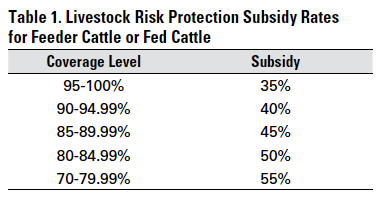Bagley Risk Management Solutions: Your Guard Versus Unpredictability
Bagley Risk Management Solutions: Your Guard Versus Unpredictability
Blog Article
Understanding Livestock Risk Security (LRP) Insurance: A Comprehensive Guide
Navigating the world of livestock danger security (LRP) insurance can be a complex undertaking for numerous in the farming industry. This kind of insurance coverage offers a safeguard against market changes and unexpected circumstances that might influence livestock manufacturers. By comprehending the details of LRP insurance coverage, manufacturers can make informed choices that may secure their operations from monetary dangers. From exactly how LRP insurance functions to the various coverage options available, there is much to uncover in this detailed overview that might possibly shape the means livestock producers come close to danger administration in their companies.

Exactly How LRP Insurance Policy Functions
Sometimes, recognizing the mechanics of Livestock Risk Security (LRP) insurance coverage can be complicated, yet damaging down how it functions can provide quality for farmers and breeders. LRP insurance is a threat administration device created to shield animals manufacturers against unanticipated cost decreases. It's crucial to note that LRP insurance policy is not a profits guarantee; instead, it focuses exclusively on cost threat defense.
Eligibility and Coverage Options

When it involves protection options, LRP insurance policy uses manufacturers the adaptability to select the insurance coverage degree, protection duration, and endorsements that best match their threat monitoring needs. Protection levels typically range from 70% to 100% of the anticipated ending worth of the insured animals. Producers can also pick insurance coverage durations that align with their manufacturing cycle, whether they are guaranteeing feeder livestock, fed cattle, swine, or lamb. Recommendations such as cost danger protection can further tailor protection to protect against damaging market variations. By comprehending the qualification criteria and insurance coverage options available, animals manufacturers can make enlightened choices to handle risk effectively.
Pros and Cons of LRP Insurance Policy
When evaluating Animals Threat Defense (LRP) insurance policy, it is necessary for livestock manufacturers to consider the negative aspects and advantages intrinsic in this threat administration tool.

One of the key benefits of LRP insurance policy is its capacity to provide protection versus a decrease in livestock costs. Additionally, LRP insurance policy provides a degree of flexibility, permitting producers to personalize coverage degrees and policy durations to suit their specific requirements.
However, there are additionally some downsides to consider. One constraint of LRP insurance is that it does not protect versus all types of threats, such as illness episodes or natural calamities. In addition, costs can in some cases be expensive, specifically for manufacturers with large livestock herds. It is essential for producers to thoroughly analyze their individual risk exposure and financial situation to identify if LRP insurance is the appropriate danger management tool for their operation.
Understanding LRP Insurance Premiums
Tips for Making Best Use Of LRP Perks
Making best use of the benefits of Animals Danger Defense (LRP) insurance policy calls for tactical preparation and positive danger administration - Bagley Risk Management. To maximize your LRP insurance coverage, think about the following ideas:
On A Regular Basis Analyze Market Conditions: Remain informed concerning market patterns and cost variations in the livestock sector. By keeping an eye on these elements, you can make enlightened decisions about when to buy LRP insurance coverage to secure versus possible losses.
Establish Realistic Protection Levels: When selecting protection levels, consider your manufacturing prices, market price of livestock, and prospective threats - Bagley Risk Management. Setting reasonable protection levels guarantees that you are properly protected without paying too much view website for unnecessary insurance coverage
Expand Your Protection: As opposed to depending entirely on LRP insurance policy, consider expanding your danger monitoring approaches. Incorporating LRP with other danger management devices such as futures agreements or choices can offer extensive coverage against market uncertainties.
Testimonial and Adjust Insurance Coverage Regularly: As market conditions transform, periodically review your LRP coverage to ensure it lines up with your current risk exposure. Changing coverage degrees and timing of acquisitions can help maximize your threat protection method. By complying with these suggestions, you can maximize the benefits of LRP insurance policy and secure your livestock operation against unforeseen dangers.
Verdict
In conclusion, animals risk defense (LRP) insurance coverage is an important tool for farmers to take care of the financial dangers connected with their livestock procedures. By understanding exactly how LRP works, eligibility and insurance coverage choices, as well as the advantages and disadvantages of this insurance coverage, farmers can make educated choices to shield their livelihoods. By meticulously thinking about LRP costs and carrying out approaches to make the most of advantages, farmers can reduce potential losses and guarantee the sustainability of their procedures.
Animals manufacturers interested in obtaining Animals Risk Defense (LRP) insurance can explore a range of eligibility requirements and coverage alternatives tailored to their certain livestock operations.When it comes to protection choices, LRP insurance policy supplies producers the adaptability to pick the coverage level, protection period, and endorsements that ideal match their danger management needs.To realize the details of Livestock Danger Protection (LRP) insurance policy completely, recognizing the elements affecting LRP insurance policy costs is important. LRP insurance coverage premiums are established by various components, consisting of check this site out the protection degree selected, the expected price of livestock at the end of the coverage duration, the kind of livestock being insured, and the size of the protection period.Review and Adjust Coverage Consistently: As market problems alter, regularly assess your LRP coverage to guarantee it aligns with your current threat direct exposure.
Report this page